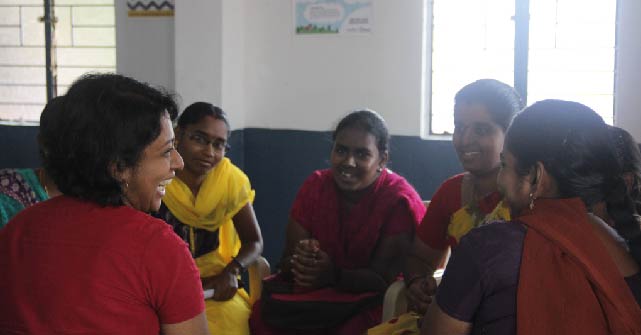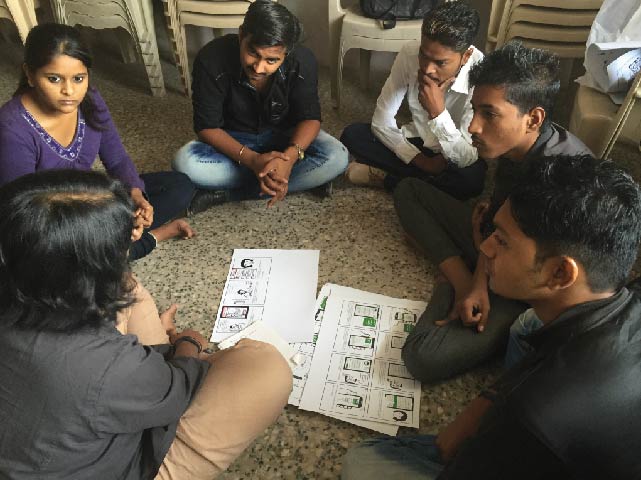
Design thinking has become a favoured methodology for innovation and user-centered design in recent years. While there is a lot of interest and excitement, the nature of this process requires sustained engagement and commitment, in order to allow for sustained change. At its core, design thinking is about empathy and a deep understanding of people’s needs — and designing for those needs.
While these sound intuitive, it often requires reflection and a willingness to evolve and adapt according to user needs; it requires the openness to challenge internal processes and methods, to listen, observe and act with humility and a learning attitude. Quicksand has been working in design thinking and user-centered design projects with Quest Alliance for almost ten years now. In a series of engagements that have evolved in complexity over time, our relationship with Quest and the team has also evolved from a vendor-client dynamic to one of close-knit collaboration through mutual explorations of complicated issues affecting the education and skills-training spaces in India.
Design thinking is talked about a lot nowadays. While we have had the privilege of working in various contexts across diverse challenges, the nature of our work means that we don’t always get to stay on and see the on-the-ground impact of our work, or be able to work through the evolving challenges that come with attempting to bring innovation to fruition. It is one of the inherent drawbacks of being a consulting firm in the design space: you try your level best to lay a design-led foundation, but ultimately it is up to your client to act on the insights that have emerged, and to take the mantle forward. In this way, Quicksand’s relationship with Quest has been very different, and by extension, exceptionally special.
Design thinking, or human-centered design, is not a new process or approach, though its value and influence has grown and expanded into more and diverse contexts in the past few years. It is predicated on empathizing and engaging with end-users or beneficiaries of a product, service, or system, and is often viewed through the lens of five distinct phases: Empathize, Define, Ideate, Prototype, and Validate.
- Empathize: Immersion in an issue or challenge to experience it from an end-user’s perspective
- Define: Building off the empathic insights, structure both the problem and a solution
- Ideate: Take the problem statement and proposed solution and craft a viable intervention
- Prototype: Create a tangible or even physical manifestation of the arrived-at intervention
- Validate: Re-engage with end-users to evaluate the intervention’s effectiveness.
These phases are cyclical, not linear. Working through each step builds in periods of divergence and convergence, and the working theory is that the more often you are able to work through these steps, the more impactful and valuable whatever it is you are designing will be for the audience you are creating it for. At times, our client-facing engagements either focus on just a few of these phases, or at most work through one or two full cycles. With our on-going and increasingly symbiotic relationship with Quest, we are able to continue exploring the various interventions we are co-creating, and see them grow from abstract conceptualization through to implementation in manifold iterations; we are able to collectively evaluate the impact and course-correct as needed to ensure maximum effect for the educational stakeholders we are working with and for.

Our engagements have ranged from working with Quest closely on adapting and evolving an academic phone-based helpline for government school teachers, to helping them build a future vision and strategic plan for the Anandshala project in Bihar. In addition, we have been close partners in Quest’s whole journey in the livelihoods and skill-development space — starting with an immersive engagement with young people and facilitators across the country to co-design the overall framework for Quest’s work in the employability space
— facilitating and building the foundation of their work with partners and facilitator capacity-building.
The most recent engagement with Quest will again be a critical aspect of their engagement strategy going forward in building a mobile learning platform. Quicksand built on the work we have done together so far in order to approach this in a more agile and prototype-focused manner. This process that would have been critically different and much slower if we did not already have the mutual relationship of trust and shared work.
The process in which we work through the phases of human-centered design is heavily predicated on intimate engagements with stakeholders. This manifests itself in activities such as embedding ourselves in communities, visiting people in their homes or schools/training institutes/workplaces, and shadowing individuals as they go through their daily routines, as well as in immersive workshops and ideation sessions that put the end-user or beneficiary of the product or service being designed at the forefront.
This is perhaps where the catch-all term ‘workshop’ creates problems, as there can be preconceived notions about what they entail, and these notions are likely to be colored by an individual’s past experiences with such activities. We are at times guilty of misusing the term, so we felt it important to call out the different manifests of ‘workshops’ that add value to our practice:
1) Ideation/Brainstorming
These sessions are useful when there is a sense of what is to be accomplished. Perhaps a new product or service has to be designed, but there is a lack of clarity in how best to do it, or there is some snag along the value chain that needs to be tweaked to get this product or service over the proverbial hump. Getting people together to identify challenges and opportunities, then working on tangible approaches to overcoming or capitalizing on them is where the value of this type of engagement shines through.
For example, Quicksand’s work with Quest on the Livelihood Connect project, which was designed to facilitate information exchange and knowledge creation in the area of livelihoods and employability. The project attempted to bring together a diverse set of practitioners to engage with insights and learnings from users, in order to challenge current practice and think about a collective way forward together. In being able to think of this platform at a time when collaboration (which is often messy and unclear) wasn’t as ‘popular’ as it is today, it is a good example of attempting to think about new programmatic engagements through engagement with young people’s needs and aspirations.
2) Visioning
There are times in which people have a sense of what they want to accomplish, but don’t have a clear idea as to how that can materialize — they need a helping hand moving from the abstract to the concrete. Quicksand facilitated a short workshop with the Quest Anandshala team to think through the future vision of the project, which aims to create child-friendly experiences in school, and decrease dropout rates. While in this case the workshop wasn’t about a new program, it was definitely about collectively thinking through a new direction and vision for it, based on learnings from recent years, as well as the evolving needs of all the ‘users’.
3) Co-creation & Co-design
This style of engagement is great for detailing out specific features of an intervention, or to create a tangible product or service to address a challenge or need. It involves identifying end-users or beneficiaries and then working with them to design interventions that are effective and valuable.
4) Training & Feedback
These sessions are useful to test out and refine products or services we are designing or prototyping. It allows you to get out of the office and involve new sets of eyes in reviewing and evaluating what you’ve designed. This is especially valuable when done with the target audience you’re working for, or at least as representative a group of individuals as possible. All our work with Quest has been centered around these aspects, both with end-users (students and facilitators at vocational training institutes) as well as with the internal Quest team. In being able to evolve program ideas and elements through a deep engagement with users’ needs and by co-creating these with them through prototypes, we have continuously attempted to anchor our work in co-design and user feedback.
—
As with the phases of design thinking themselves, we typically employ only a few of these different workshop environments in each of our engagements. Through a long-term relationship with Quest, we have been able to not only utilize each of these approaches, but have also seen Quest’s design literacy grow to the extent that they themselves use these environments independent of Quicksand to unpack various aspects of their own practice. This, more than anything, speaks of the passion and interest that Quest has for design thinking and incorporating innovative problem-solving methodologies in their own practice.
We have had the great fortune of working very closely with Quest for much of the time Quicksand has existed as a practice. This has afforded us a front-row view of their growth vis-a-vis design capacity, but more importantly also in the great value that this approach has added to the programs they have developed both independently and with us. The effect being greater impact for the students, teachers, and other stakeholders that benefit from these programs. And at the end of the day, the true metric for the effectiveness of human-centered design is its ability to tangibly and meaningfully improve the quality of life of the individuals being designed for.

Babitha George
Partner & Anchor, Quicksand

Kevin Shane
Principal & Communications Lead, Quicksand
This article was originally published in The Learner 2017
